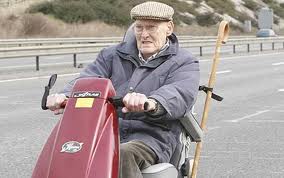Mobility Scooter rules and regulations
Did you know that it is NOT compulsory for mobility scooter users to have insurance to ride on the pavements ?
Driving on footpaths and parking
All mobility scooters and powered wheelchairs can legally travel at a maximum speed of 4 mph on footpaths or in pedestrian areas.
No type of mobility scooter or powered wheelchair can be driven on a cycle paths marked ‘cycle only’.
Parking
All normal parking restrictions apply to mobility scooters and powered wheelchairs ! I didn’t know that !
Mobility scooters should not be left on a footpath or pedestrian area on its own if it gets in the way of other pedestrians, including wheelchair users and people with prams or pushchairs.
Some mobility scooters can be used on the road but they need to meet certain extra rules. Otherwise users can be stopped by the police.
- Class 3 invalid carriages need to have the following important features:
- a device to limit its speed to 4mph
- a maximum speed of 8mph
- an efficient braking system
- front and rear lights and reflectors
- direction indicators able to operate as a hazard warning signal
- an audible horn
- a rear view mirror
-
If used on a dual carriageway, the mobility scooter must have a flashing amber light …..perish the thought !!!!!
Mobility scooters rules and regulations state that they also need to be
- a maximum unladen weight of 150 kilograms
- a maximum width of 0.85 metres
Eyesight requirements
Although regulations state there are no legal eyesight requirements mobility scooter users should be able to read a car’s registration number from a distance of 12.3 metres (40 feet) and this needs to be regularly checked.
Scooter users may have to pay compensation if they have an accident and poor eyesight was part of the cause.
Use of mobility scooters by non-disabled people
Mobility scooters and powered wheelchairs can only be used by non-disabled people if they’re:
- demonstrating the vehicle before it’s sold
- training a disabled user
- taking the vehicle to or from maintenance or repair

